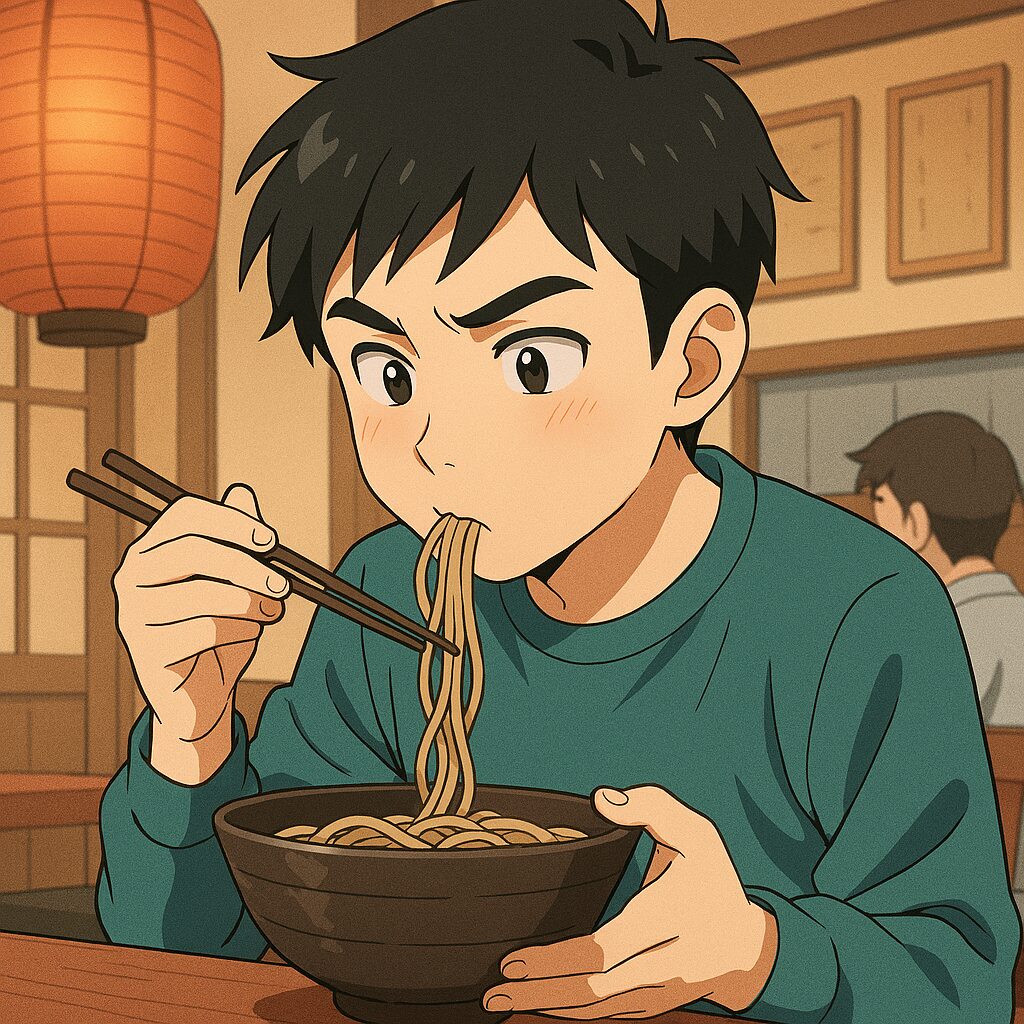Step into a quiet soba shop in Japan, and you’ll likely hear a chorus of slurping sounds echoing from every table. For many first-time visitors, this noisy ritual can be surprising—even confusing.
“Why do they eat so loudly?”
“Isn’t that rude?”
In Japan, the answer is simple: “That’s how you enjoy it best.”
This article explores the reasons behind Japan’s noodle-slurping tradition, revealing its roots in flavor, etiquette, and cultural philosophy. Whether you’re a curious traveler or a noodle enthusiast, you’ll discover that slurping is far more than just a sound—it’s a celebration of taste and tradition.
- 🏮 Chapter 1: Slurping Is Not Rude in Japan
- 🍥 Chapter 2: The Flavor Behind the Slurp
- 🕰️ Chapter 3: Edo-Era Origins and Street Food Culture
- 🌏 Chapter 4: Foreign Reactions and “Noodle Harassment”
- 🧠 Chapter 5: Slurping as Gratitude
- 🥢 Chapter 6: How to Try Slurping Yourself
- 📝 Conclusion: The Beauty Within the Sound
- 🏮第一章:すするという行為は、無作法ではない
- 🍥第二章:風味を引き出す「すする技術」
- 🕰️第三章:江戸の粋と屋台文化
- 🌏第四章:外国人の反応と「ヌードル・ハラスメント」
- 🧠第五章:すすることは、感謝の表現でもある
- 🥢第六章:初めての「すする」体験に挑戦してみよう
- 📝まとめ:すする音に宿る、日本の美意識
🏮 Chapter 1: Slurping Is Not Rude in Japan
In many Western cultures, making noise while eating is considered impolite. Quiet dining is often seen as refined, and slurping might be viewed as bad manners.
But in Japan, things are different. When it comes to noodles—soba, ramen, udon—slurping is not only accepted, it’s encouraged. It’s a way to show appreciation and enjoyment.
For a deeper explanation, check out this article from a soba shop in Fukushima:
👉 Why do Japanese people slurp their soba?
🍥 Chapter 2: The Flavor Behind the Slurp
Slurping noodles draws air into the mouth, enhancing aroma and cooling the noodles as they enter. This technique allows the full flavor of the soba to bloom—similar to how wine tasting involves aeration to release its bouquet.
Hot soba especially benefits from slurping, as it prevents burns and lets you enjoy the dish more comfortably. In short, slurping is both practical and delicious.
🕰️ Chapter 3: Edo-Era Origins and Street Food Culture
The slurping custom dates back to the Edo period, when busy townspeople grabbed quick meals at soba stalls. Eating fast and efficiently was part of the urban lifestyle, and slurping became a symbol of stylish, no-nonsense dining.
This idea of iki—a refined simplicity—shaped many aspects of Japanese culture, including how soba is eaten. Slurping was not just functional, but fashionable.
🌏 Chapter 4: Foreign Reactions and “Noodle Harassment”
In recent years, the term “noodle harassment” (or “nu-hara”) emerged, referring to the discomfort some foreigners feel when hearing loud slurping in Japan.
However, surveys show that most international visitors are curious rather than offended. In fact, many embrace the custom once they understand its meaning.
For more insights, see this article:
👉 The history and meaning of Japan’s slurping culture
🧠 Chapter 5: Slurping as Gratitude
In Japan, eating with enthusiasm is a way to thank the chef. Slurping is not just about taste—it’s a heartfelt compliment. The sound says, “This is delicious!”
Where silence might be polite elsewhere, in Japan, sound becomes a form of emotional expression. It’s a language of appreciation that transcends words.
🥢 Chapter 6: How to Try Slurping Yourself
If you’re visiting Japan, slurping might feel awkward at first. But don’t worry—give it a try! It’s part of the experience.
To slurp, purse your lips and inhale the noodles like you would with a straw. Try not to bite halfway—slurp all the way through if you can. It’s okay to go at your own pace.
👉 Why do Japanese people slurp noodles?
📝 Conclusion: The Beauty Within the Sound
Slurping soba is more than a quirky habit—it’s a reflection of Japanese aesthetics. It connects flavor, seasonality, and respect in one simple gesture.
In a world where silence is often equated with manners, Japan offers a different perspective: sometimes, sound is the most sincere way to say “thank you.”
So next time you visit Japan, step into a soba shop, take a deep breath—and slurp with confidence. Within that sound, you’ll taste not just noodles, but the heart of a culture.
🍜「ズズズッ」は美味しさの音?
―日本人が蕎麦をすする理由と、その奥深い文化背景―
静かな蕎麦屋の暖簾をくぐると、聞こえてくるのは「ズズズッ」という音の合唱。初めて日本を訪れた外国人観光客の中には、この音に驚き、戸惑う人も少なくありません。
「なぜ音を立てて食べるの?」「マナー違反じゃないの?」――そんな疑問に、日本人はこう答えるでしょう。
「それが、美味しい食べ方なんです。」
この記事では、日本人が蕎麦をすする理由を、歴史・文化・味覚の観点から紐解きながら、海外の方にもわかりやすくご紹介します。
🏮第一章:すするという行為は、無作法ではない
多くの国では、食事中に音を立てることは「マナー違反」とされています。特にヨーロッパでは、静かに食べることが上品とされ、音を立てると「育ちが悪い」と見なされることもあります。
しかし、日本では事情が異なります。蕎麦やラーメン、うどんなどの麺類に限っては、音を立ててすすることが「美味しさの表現」として受け入れられているのです。
この文化的違いについては、福島県の蕎麦屋「十割げた蕎麦 真なり」さんが詳しく解説しています。
👉 なぜ日本人は蕎麦を食べる際に、音を立てて啜るのか?
🍥第二章:風味を引き出す「すする技術」
蕎麦をすすることで、麺と一緒に空気を口に取り込みます。これにより、蕎麦の香りが鼻へ抜け、風味がより豊かに感じられるのです。これは、ワインのテイスティングで空気を含ませて香りを楽しむのと似ています。
また、熱い蕎麦をすすることで、自然に空気が入り、麺が冷まされて火傷を防ぐ効果もあります。つまり、「すする」は美味しさと安全性を両立させる合理的な食べ方なのです。
🕰️第三章:江戸の粋と屋台文化
蕎麦をすする文化は、江戸時代に広まりました。当時の庶民は、忙しい日常の中で立ち食い蕎麦屋に立ち寄り、素早く食事を済ませていました。
「ズズズッ」と音を立てて食べることは、手早く、粋に食べる江戸っ子の美学でもあったのです。
この「粋(いき)」という価値観は、無駄を省きつつも洗練された振る舞いを重んじるもので、蕎麦をすする所作もその一部でした。
🌏第四章:外国人の反応と「ヌードル・ハラスメント」
近年、「ヌードル・ハラスメント(ヌーハラ)」という言葉が話題になりました。これは、麺をすする音が外国人に不快感を与えるという議論から生まれた言葉です。
しかし、実際には多くの外国人がこの習慣を理解し、受け入れています。英語圏向けメディア「SoraNews24」が行ったアンケートでは、約89%の回答者が「不快ではない」と答えています。
🧠第五章:すすることは、感謝の表現でもある
日本では、料理を作ってくれた人への感謝を「美味しそうに食べる」ことで伝える文化があります。蕎麦をすする音は、その感謝の気持ちを表す一つの方法でもあるのです。
「ズズズッ」という音は、料理人にとっては「美味しい!」という最高の賛辞。静かに食べることが礼儀とされる国もありますが、日本では「音」が感情を伝える手段になっているのです。
🥢第六章:初めての「すする」体験に挑戦してみよう
訪日観光客の方にとって、麺をすするのは少し勇気がいるかもしれません。でも、せっかく日本に来たなら、ぜひ一度体験してみてください。
口をすぼめて、ストローで飲み物を吸うように麺を吸い上げる――それが「すする」基本動作です。途中で噛み切らず、最後まで一気にすするのが「粋」とされていますが、無理せず自分のペースで楽しんでください。
📝まとめ:すする音に宿る、日本の美意識
蕎麦をすするという行為は、単なる食べ方ではありません。それは、風味を味わい、季節を感じ、職人への敬意を表す、日本独自の美意識の表現です。
音を立てて食べることが無作法とされる国もありますが、日本では「ズズズッ」が美味しさの証。文化の違いを知ることで、旅はもっと豊かになります。
次に日本を訪れたときは、ぜひ蕎麦屋の暖簾をくぐり、「ズズズッ」とすする勇気を持ってみてください。
その音の中に、日本の四季と心が、きっと宿っています。



コメント